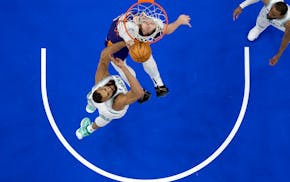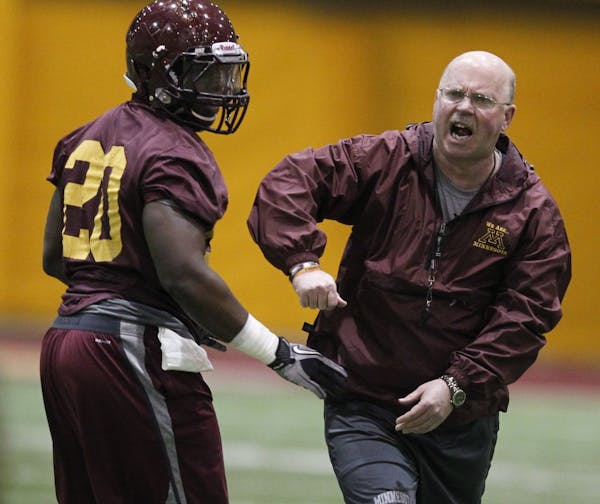They are the most fortified 5 yards in football, the territory between the defensive line and a quarterback who's looking for a receiver. Take five seconds to fight through a wall of bodyguards, and a quarterback turns into Aaron Rodgers. But get there in three seconds, and he turns into Mr. Rogers.
So two seconds -- that's it. That's the difference between bottling up an offense and ... well, doing what the Gophers did last season.
"You'd be surprised what just a little bit more speed can do," said Gophers defensive coordinator Tracy Claeys, whose primary task this fall is eliminating those two extra seconds. "How often do you see a guy arrive [at the quarterback] one step late? One step can change the game."
Sounds simple, and the Gophers have heard those lectures all fall. Ask defensive end D.L. Wilhite why Minnesota's pass rush was historically toothless last season -- the Gophers sacked the quarterback only nine times, fewer than any other team in Division I football -- and he says, "I guess we weren't running fast enough."
He's not joking, though. Under Jerry Kill's philosophy, speed is the most precious, irreplaceable commodity on a defense, and his coaching staff has dedicated itself to find and develop more of it. Summer workout programs didn't stop at weightlifting and strength training but were designed to make pass rushers as nimble as they are ferocious.
The speed of redshirt freshman Ben Perry helped him rise to the top of the depth chart this fall, and quick linebackers such as Keanon Cooper and Gary Tinsley are being counted on to get into the backfield.
But the real difference, the coaches hope, comes with a new attitude about defense and getting to the quarterback. They are great believers in the value of pressure, and are willing to take calculated risks in order to create it.
"When you apply pressure to anyone, people make mistakes. And that's true in any walk of life, not just football," Claeys said. "When you create pressure on the quarterback, he's going to make more bad decisions, mental mistakes; he's going to make more physical mistakes -- tipped passes or bad mechanics; and he's going to have it on his mind, so you affect not only that play but maybe the next one, too."
"It's just a different mentality. Now, every play is a pass rush," Wilhite said. "Before, we were focused on being gap-sound, not giving your guy open space. This is so much more aggressive, it feels like a different way to play."
Proven track record
The benefits outweigh the risk of an occasional mistake, Claeys figures. He doesn't consider himself a gambler but said he considers aggressiveness to be more disruptive than a conservative mind-your-gaps strategy.
"You have to make the offense feel stressed. The more pressure you apply, the better the chance they'll make a mistake," Claeys said. "We want speed, we want energy. We want to get to the quarterback or make him get rid of it. The quicker the ball comes out, the sooner you can run after it."
Kill and Claeys have the track record to prove it works. In three seasons at Northern Illinois, Claeys' defense led the Mid-American Conference in either total defense or scoring defense each year. And the Huskies sacked the quarterback at least 30 times in each of the past two seasons, something the Gophers have accomplished only once in the past decade.
"You don't have to sack the quarterback to stop an offense," Claeys said. "But it helps."
To produce more sacks -- Minnesota has recorded 15 or fewer three times in the past six seasons -- the Gophers intend to bring pass rushers from more angles and frequently change assignments. Linebackers will be loosed on the offense, a substantial change for a defense that became so concerned with its inability to stop the run last year that it rarely blitzed.
Wilhite, for one, says he can see the results of telling Cooper, who lines up outside, to sic the quarterback.
"Coop's a lot faster than me. You get him out there on the edge, it gives us a whole different look," the junior from Louisville said. "I'm doing moves out there, working my guy, and he'll just tear right past me. So it opens up a lot of stuff for us."
"If you can create pressure by rushing three and dropping eight back, you're going to be pretty good," Claeys said. "But more realistically, you're going to have to give the guys on the line some help."
They'll also substitute more than most teams, in order to keep players fresh.
"At Northern, it would look like a hockey line change, we roll so many kids in and out," Claeys said. "Kids want to play an aggressive style of defense, and they know they can go hard, because we won't let them wear down."
Even the Gophers offensive linemen, who work against that defense in practice every day, say the change is noticeable.
"Oh yeah, the D-line has improved immensely since last year," left tackle Ed Olson said. "They're using their hands so much more now, they're much more effective."
Putting pressure on the quarterback might be the goal. But for the moment, the pressure is on the defensive line.
"Part of me wants to say it's a team game, and [pass rushing] is just one part of it," Wilhite said. "But deep down we know if we don't go out and produce sacks, it's going to be hard for us to win this year. DBs have to cover, linebackers have to cover, but at the end of the day, getting sacks, getting to the quarterback is going to directly change the outcome of games."

Souhan: Wolves fans made Game 1 something special. Now bring on Game 2.

Will Wolves show best-in-the-NBA defensive form in Game 2?
NFL draft has been on tour for a decade and the next stop is Detroit, giving it a shot in spotlight

Former Totino-Grace star set to follow father as first-round pick

